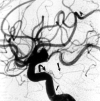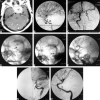Endovascular access to the meningohypophyseal trunk
- PMID: 11290487
- PMCID: PMC7976022
Endovascular access to the meningohypophyseal trunk
Abstract
We describe a novel technique to selectively catheterize the meningohypophyseal trunk (MHT) and its branches. We emphasize the difficulty in accessing the MHT via an ipsilateral approach because of the geometric orientation of this vessel to the parent internal carotid artery.
Figures


Similar articles
-
[Successful treatment using detachable coils for traumatic carotid cavernous fistula as a complication of transsphenoidal surgery for a pituitary adenoma: a case report].No Shinkei Geka. 2000 Feb;28(2):167-71. No Shinkei Geka. 2000. PMID: 10666737 Japanese.
-
Incidental ethmoidal dural arteriovenous fistula coexisting with a pituitary adenoma exacerbating post-transsphenoidal epistaxis.Br J Neurosurg. 2019 Dec;33(6):681-683. doi: 10.1080/02688697.2017.1400521. Epub 2017 Nov 9. Br J Neurosurg. 2019. PMID: 29119835
-
Embolization of meningohypophyseal and inferolateral branches of the cavernous internal carotid artery.AJNR Am J Neuroradiol. 1999 Jun-Jul;20(6):1061-7. AJNR Am J Neuroradiol. 1999. PMID: 10445445 Free PMC article.
-
Spontaneous carotid-cavernous fistula supplied by the contralateral meningohypophyseal trunk: case report and literature review.J Neurosurg Sci. 2010 Mar;54(1):45-8. J Neurosurg Sci. 2010. PMID: 20436398 Review.
-
Carotid cavernous fistula and false aneurysm of the cavernous carotid artery: complications of transsphenoidal surgery.Neurosurgery. 1992 Oct;31(4):774-8; discussion 778-9. doi: 10.1227/00006123-199210000-00025. Neurosurgery. 1992. PMID: 1407467 Review.
Cited by
-
Bailout using NBCA for incomplete onyx embolization of tentorial dural arteriovenous fistula.Radiol Case Rep. 2024 Aug 22;19(11):5153-5157. doi: 10.1016/j.radcr.2024.07.138. eCollection 2024 Nov. Radiol Case Rep. 2024. PMID: 39263518 Free PMC article.
-
Iatrogenic Pseudoaneurysm of the Meningohypophyseal Trunk; A Rare Complication of Trans-sphenoidal Surgery.Clin Neuroradiol. 2015 Sep;25(3):309-11. doi: 10.1007/s00062-014-0340-4. Epub 2014 Aug 28. Clin Neuroradiol. 2015. PMID: 25164694 No abstract available.
-
Case report: Onyx embolization of tentorial dural arteriovenous fistula via the meningohypophyseal trunk and medial tentorial artery of Bernasconi-Cassinari.Front Neurol. 2022 Aug 10;13:904877. doi: 10.3389/fneur.2022.904877. eCollection 2022. Front Neurol. 2022. PMID: 36034295 Free PMC article.
-
Cavernous sinus dural fistula treated by transvenous facial vein approach.Interv Neuroradiol. 2004 Mar 14;10(1):69-74. doi: 10.1177/159101990401000109. Epub 2004 Oct 22. Interv Neuroradiol. 2004. PMID: 20587267 Free PMC article.
References
-
- Lewis AI, Tomsick TA, Tew JM Jr. Management of tentorial dural arteriovenous malformations: transarterial embolization combined with stereotactic radiation or surgery. J Neurosurg 1994;81:851-859 - PubMed
-
- Pribram HFW, Boulter TR, McCormick WMF. The roentgenology of the meningohypophyseal trunk. AJNR Am J Neuroradiol 1966;98:583-594 - PubMed
-
- Higashida RT, Hieshima GB, Halbach VV, Goto KG. Closure of carotid cavernous sinus fistula by external compression of cervical carotid artery and jugular vein. Acta Radiol (Suppl) 1986;369:580-583 - PubMed
-
- Miyazaki Y, Yamamoto I, Shinozuka S, Sato O. Microsurgical anatomy of the cavernous sinus. Neurol Med Chir 1994;34:150-163 - PubMed
Publication types
MeSH terms
LinkOut - more resources
Full Text Sources
Medical
